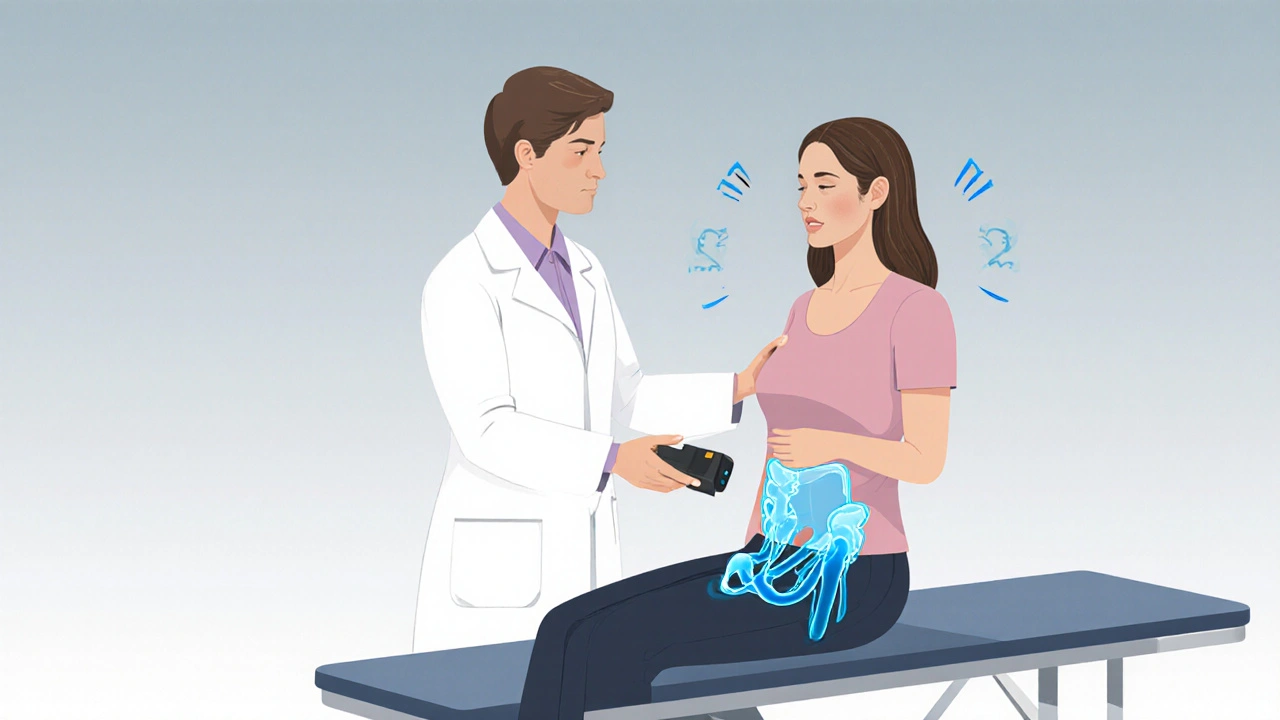PFMT Exercise Timer & Tracker
Exercise Timer
Track your pelvic floor muscle training sessions with our timer. Proper timing is essential for effective PFMT.
According to the article: "Contract and hold for 3-5 seconds, then relax for the same amount of time. Aim for 10-15 repetitions per set."
Progress Tracker
Track your consistency and progress over time. Consistency is key for PFMT effectiveness.
Recent Sessions
When it comes to bladder control, pelvic floor muscle training is a series of targeted exercises that strengthen the muscles supporting the bladder and urethra. If leaks sneak up during a laugh, a jog, or a sudden urge to go, the right routine can turn the tide without pills or surgery.
Key Takeaways
- PFMT works for both stress and urge urinary incontinence by improving muscle tone and coordination.
- Consistent practice (3-4 times daily) yields noticeable benefits in 6‑8 weeks.
- A simple bladder diary helps you track triggers and measure progress.
- Professional guidance from a physiotherapist can fine‑tune technique and speed results.
- When PFMT isn’t enough, it can be combined with medication or minimally invasive procedures for added relief.
What Is Pelvic Floor Muscle Training?
The pelvic floor is a hammock of pelvic floor muscles that sit beneath the bladder, uterus (in women), and rectum. They keep the urethra closed and help push urine out when you need to go. Over time, pregnancy, aging, heavy lifting, or chronic coughing can weaken this sling, leading to urinary incontinence.
PFMT is essentially a workout plan for that hammock. The most famous version is the Kegel exercise, named after Dr. Arnold Kegel who introduced it in the 1940s. The core idea is simple: contract the muscles you’d use to stop mid‑stream urine, hold, then release. Repeating this while varying the hold time builds both strength and endurance.
How PFMT Helps Different Types of Incontinence
There are two main buckets of urinary incontinence:
- Stress incontinence - leaks when pressure spikes (coughing, sneezing, lifting).
- Urge incontinence - a sudden, intense need to pee that can’t be delayed.
For stress incontinence, stronger pelvic floor muscles act like a tighter seal around the urethra, reducing pressure‑induced leaks. For urge incontinence, training improves the timing between the bladder’s contraction signals and the pelvic floor’s response, giving you a chance to reach the bathroom.
Clinical studies from 2022‑2024 show that regular PFMT reduces leak episodes by 40‑60% in stress incontinence and by 30‑45% in urge incontinence when done correctly.

Getting Started: Simple Steps and Common Mistakes
- Locate the right muscles: try stopping your urine flow mid‑stream. The muscles you engage are the ones you’ll train. (Don’t make a habit of stopping flow; it can cause urinary retention.)
- Adopt a comfortable position - seated, standing, or lying down. Beginners often start lying on their back with knees bent.
- Contract and hold for 3‑5 seconds, then relax for the same amount of time. Aim for 10‑15 repetitions per set.
- Progress to 8‑10 second holds and add “quick‑pulse” sets (10 rapid contractions) to boost endurance.
- Schedule 3‑4 sessions daily: morning, lunch, evening, and before bed.
Common pitfalls:
- Using abdominal, glute, or thigh muscles instead of the pelvic floor - you’ll feel a “tightening” in the belly instead of a subtle lift.
- Holding your breath - breathe normally throughout each contraction.
- Skipping the relaxation phase - muscles need equal time to recover.
- Expecting overnight miracles - consistency over weeks is the secret.
When to Seek Professional Guidance
While many people master PFMT at home, a physiotherapist trained in pelvic health can spot technique flaws, recommend biofeedback tools, and tailor programs for specific conditions (e.g., post‑prostate surgery, postpartum recovery).
Consider a professional visit if:
- Leaks persist after 8 weeks of diligent practice.
- You’re unsure whether you’re contracting the correct muscles.
- You have a neurological condition (multiple sclerosis, spinal cord injury) that may affect muscle control.
- You want a personalized program that includes stretching, core stabilization, and lifestyle advice.
Comparing PFMT with Other Treatments
| Option | Effectiveness (average reduction in leak episodes) | Invasiveness | Typical Cost (US$) | Side‑effects / Risks |
|---|---|---|---|---|
| Pelvic Floor Muscle Training | 40‑60% (stress) / 30‑45% (urge) | Non‑invasive | 0‑200 (apps or printed guides) | Minimal; occasional muscle fatigue |
| Anticholinergic Medications | 30‑50% (urge) | Oral medication | 40‑120 per month | Dry mouth, constipation, cognitive fog (especially >65) |
| Mid‑Urethral Sling Surgery | 70‑90% (stress) | Surgical (minor invasive) | 3,000‑8,000 (including hospital stay) | Infection, mesh erosion, urinary retention |
Notice how PFMT stacks up: it’s the cheapest, safest first‑line option. If you need faster relief or have severe symptoms, the table helps you decide whether to add medication or consider surgery after a solid PFMT foundation.
Tracking Progress: Tools You Can Use
A bladder diary is the simplest yet most powerful monitoring tool. Record:
- Time of each void.
- Fluid intake (type and volume).
- Any leakage episodes (duration, activity).
- PFMT session completion.
After two weeks, you’ll see patterns - maybe coffee spikes urgency or a specific exercise set correlates with fewer leaks. Apps like “UroTrack” or “Kegel Trainer” sync with phone reminders and give visual graphs of progress.
Other optional aids:
- Biofeedback devices - small vaginal or rectal sensors that beep when you contract correctly.
- Weighted vaginal cones - help you gauge strength by holding weight for set periods.
Next Steps: Building a Sustainable Routine
1. Pick a cue. Tie PFMT to daily habits - brushing teeth, coffee break, TV commercial.
2. Set realistic goals. Start with 3 sets of 10 contractions per day; add a quick‑pulse set after two weeks.
3. Log it. Use a notebook or app to mark each session; review weekly.
4. Re‑evaluate. After 8 weeks, assess leak frequency. If improvement stalls, schedule a consult with a pelvic‑health physiotherapist.
5. Combine wisely. If you still have occasional leaks, discuss adding a low‑dose anticholinergic or a minimally invasive sling with your urologist - but keep PFMT as the backbone.
Frequently Asked Questions
How long does it take to see results from PFMT?
Most people notice a reduction in leaks after 4‑6 weeks of consistent practice. Full benefit often appears around 8‑12 weeks.
Can men benefit from pelvic floor exercises?
Yes. Men use PFMT to improve post‑prostate‑surgery continence, reduce nocturia, and even strengthen erections.
Is it safe to do PFMT during pregnancy?
Absolutely. In fact, prenatal PFMT can prevent postpartum stress incontinence and aid labor recovery. Just avoid over‑exertion and follow a clinician’s guidance.
Do I need special equipment?
No equipment is required. A smartphone app or a simple timer works fine. If you want feedback, a small biofeedback probe or weighted cone can be added later.
What if my leaks get worse while training?
Worsening may signal improper technique or an underlying condition. Pause the home program, review your contractions, and book an appointment with a pelvic‑health physiotherapist.






Vintage Ireland
Reading about PFMT always makes me think of life as a series of tiny contracts – each one a promise we keep with our own bodies. It’s like planting a seed each morning and watching it grow with patience. The key, as the article says, is consistency, not occasional heroics. If you tie it to a daily habit – coffee, a TV break, a stretch – it becomes part of your rhythm. Ultimately, those little lifts add up to a big sense of freedom.
Anshul Gupta
Sure, the guide sounds nice on paper, but most people will never bother with the “10‑15 reps” routine. By the time they remember to breathe, the day’s already over.
Gene Nilsson
It is an undisputed moral imperative that individuals embrace non‑invasive methods to mitigate their domestic health concerns; thus, the advocates of PFMT are undeniably commendable. Yet, one must also recognize the foolishness of those who neglect such proven regimens in favour of fleeting comforts. Let us, therefore, enjoin upon each citizen the duty to act responsibly – even if occasional typ0s slip into our communications.
Erika Ponce
One simple tip: set a phone reminder to do a quick set of squeezes after you brush your teeth – it’s easy, no fancy equipment needed, and you’ll start to notice fewer leaks.
Danny de Zayas
Consistency beats intensity every time.
John Vallee
Imagine your pelvic floor as a loyal squad of tiny guardians, each contraction a valiant salute to your bladder’s security. When you train them regularly, they become resolute, standing guard through coughs, lifts, and even the occasional giggle. This transformation isn’t magic; it’s science wrapped in perseverance. The schedule suggested-morning, lunch, evening, bedtime-mirrors the rhythm of a well‑orchestrated symphony, each movement reinforcing the next. Do not be discouraged by early setbacks; muscles, like any skill, need time to adapt. Celebrate each completed set as a small victory, and soon those victories will compound into lasting confidence. Remember, the journey is personal: tailor the hold times to your comfort, then gradually extend them. With dedication, the once‑troublesome leaks will fade into a distant memory, replaced by a newfound sense of control.
Brian Davis
From a cultural perspective, it’s fascinating how different societies approach pelvic health. In many Asian traditions, the concept of “Qigong” embraces core and pelvic awareness long before the term PFMT entered the Western lexicon. Meanwhile, European physiotherapy has formalized protocols that align closely with the guidelines outlined here. Bridging these perspectives can enrich our understanding – perhaps incorporating mindful breathing from Eastern practices into the structured repetitions advocated in the West. Such a hybrid approach might make adherence more engaging for a global audience.
Sandra Perkins
Oh great, another “just do it” guide – because we all have time to count seconds.
Audrin De Waal
Listen, our nation prides itself on tough grit, yet we ignore the quiet battles our citizens face every time they laugh or lift. PFMT is a home‑grown solution that honors that spirit – no foreign pills, just disciplined effort. It’s high time we champion it as part of our national health agenda, showing the world that true strength starts from within.
jenni williams
Hey, you’re not alone in this journey – every squeeze is a step toward freedom 😊. Keep breathing, stay gentle, and trust the process; the results will surprise you.
Craig Jordan
While many hail PFMT as a panacea, I remain skeptical of the over‑optimistic claims. The literature often cherry‑picks studies with small sample sizes, inflating effectiveness percentages. Moreover, the one‑size‑fits‑all protocol neglects individual anatomical variations and comorbidities that can blunt outcomes. A more nuanced, patient‑specific approach, perhaps integrating biofeedback selectively, would be a more honest representation of reality than the blanket endorsement we see here.
Maryanne robinson
First and foremost, congratulations on taking the first step toward reclaiming control over your bladder – that’s a huge victory in itself.
When you begin any PFMT routine, think of it as building a foundation for a sturdy house. Each contraction is a brick, and consistency is the mortar that holds everything together. Start with three sets of ten gentle squeezes each day, making sure you truly feel the lift in the pelvic floor rather than just tightening your abdomen or buttocks.
It can be helpful to pair your exercises with a daily cue – perhaps while brushing your teeth in the morning, during a coffee break, or while watching your favorite TV show. Over time, these cues become automatic triggers, ensuring you never miss a session.
Track your progress using a simple notebook or a phone app. Note the number of repetitions, hold times, and any changes you notice in leak frequency. Seeing tangible data can be incredibly motivating and will help you spot patterns, like whether caffeine spikes are affecting urgency.
If you find it challenging to isolate the correct muscles, consider using a biofeedback device or consulting a pelvic‑health physiotherapist for a quick assessment. A professional can provide immediate feedback, correcting any inadvertent use of surrounding muscles.
Remember to breathe normally throughout each contraction; holding your breath creates unnecessary tension and reduces the effectiveness of the exercise.
Gradually, as strength improves, extend the hold time from three seconds up to eight or ten seconds, and incorporate “quick‑pulse” sets – ten rapid squeezes to boost endurance.
Don’t be discouraged if you don’t see dramatic changes within the first week. Like any muscle group, the pelvic floor requires weeks of consistent training before noticeable improvements appear.
By the eight‑week mark, many users report a 40‑60% reduction in leak episodes. If you reach this milestone without seeing progress, it’s a signal to seek professional guidance – perhaps an adjusted program or additional therapeutic modalities.
Throughout this journey, maintain a positive mindset. Celebrate each completed set, no matter how small, and recognize that every effort brings you closer to the freedom you deserve.
Finally, keep in mind that PFMT is a lifelong habit. Even after symptoms improve, continuing a maintenance routine (one or two sessions per day) will help preserve the gains you’ve worked hard to achieve.